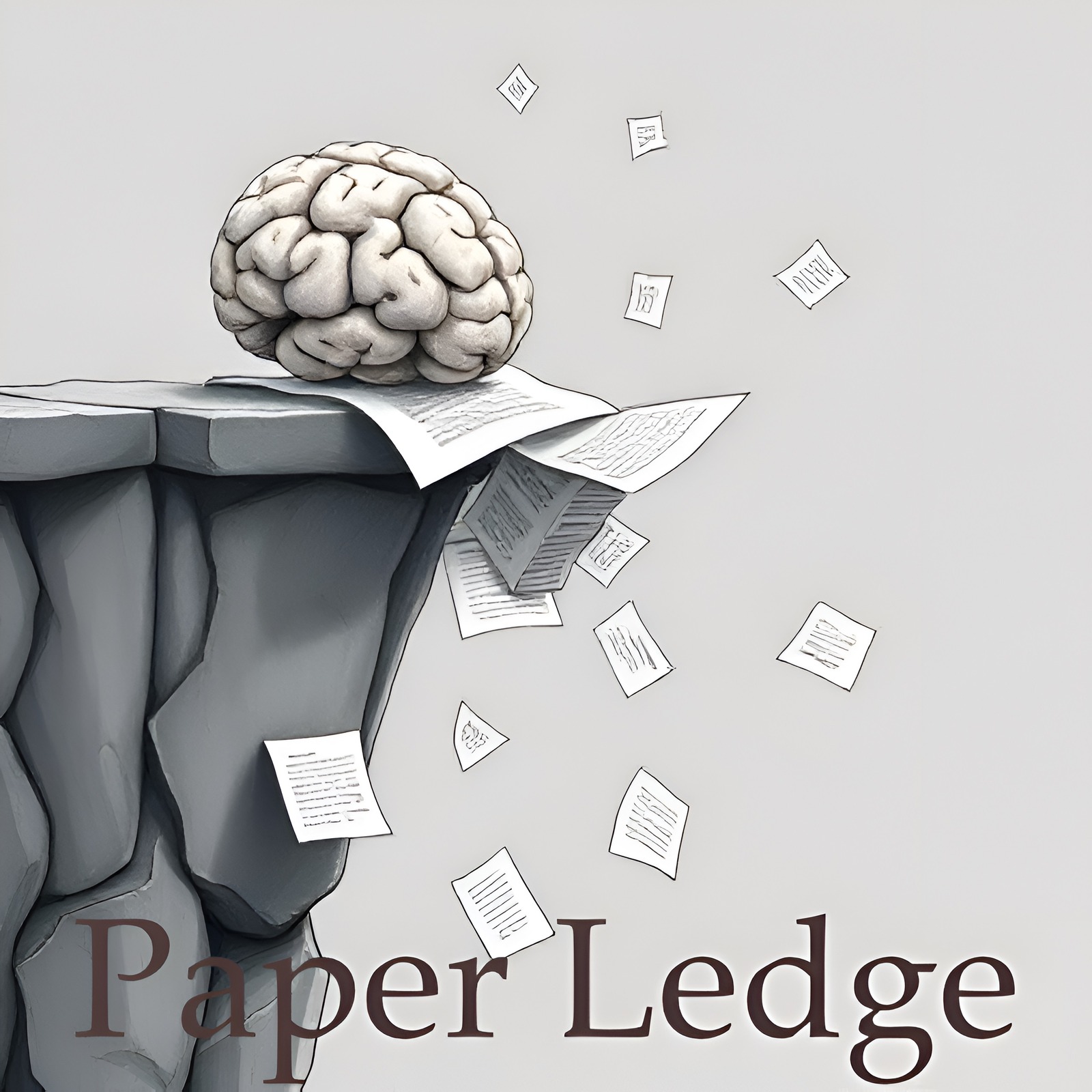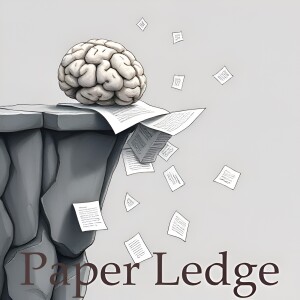PaperLedge

PaperLedge where research meets storytelling is a revolutionary podcast where cutting-edge research meets AI-powered storytelling. Hosted by the Ernis, whose blend of gentle reassurance, cosmic wonder, explanatory clarity, and enthusiastic charm makes complex research accessible to everyone. Each episode, Ernis transforms the latest academic papers into engaging, jargon-free audio experiences that deliver key insights in digestible formats. Whether you’re a researcher seeking interdisciplinary perspectives, a student supplementing your studies, or simply curious about scientific breakthroughs, PaperLedge has something for you.
Episodes
Episodes



Tuesday Oct 07, 2025
Tuesday Oct 07, 2025
Hey PaperLedge learning crew, Ernis here, ready to dive into some seriously cool AI research! Today, we're unraveling a paper that tackles a tricky problem with a new type of language model – think of it as giving these models a second chance to get things right.
Now, you've probably heard of language models like ChatGPT. Most of them are what we call "autoregressive," meaning they predict the next word in a sentence, one word at a time, building on what they've already said. But there's a new kid on the block: diffusion language models (dLLMs). Imagine painting a picture. Instead of adding brushstrokes sequentially, you start with a blurry image and gradually refine it. dLLMs work similarly, refining the entire sentence all at once, in parallel. This can be much faster!
But here's the catch: the original way dLLMs decoded text had a significant flaw. Once a word was chosen, it was locked in, even if it was wrong! Think of it like a typo in a tweet that you can’t edit – it just sits there, potentially messing up the whole message. The researchers call this a critical limitation.
"Early mistakes persist across iterations, harming both intermediate predictions and final output quality."
That's where the magic of this paper comes in. The researchers introduce a new technique called Tolerator. It’s a clever way to let dLLMs reconsider their earlier choices and fix mistakes. And the best part? It doesn't require any extra training of the model itself!
So, how does Tolerator work? It's a two-step process. First, the dLLM fills in the entire sequence, making its initial guesses for all the words. Then comes the iterative refinement stage. Imagine a group of editors proofreading a document. Tolerator essentially "remasks" a portion of the words – hiding them again – and then asks the model to re-predict those words, using the surrounding words as context. This allows the model to cross-validate its choices and correct any errors it might have made initially.
Think of it like this: imagine you're writing an email and you're not sure about a particular word. You could ask a friend to read the email and tell you if the word sounds right in context. That’s similar to how Tolerator works, letting the dLLM use the surrounding words to double-check its own choices.
Step 1: Sequence Fill-Up: The model makes its first guess at the entire sentence.
Step 2: Iterative Refinement: The model re-evaluates parts of the sentence based on the context of the rest.
The researchers tested Tolerator on a bunch of different tasks, from understanding language to generating code and solving math problems. And guess what? It consistently improved the performance of dLLMs! This shows that how we decode the output of these models is just as important as the model itself. It's like having a super-smart engine but needing a better steering wheel to guide it effectively.
Why does this matter? Well, for AI researchers, it's a significant step forward in making dLLMs more reliable and accurate. For developers, it means potentially building better applications using these models. And for everyone else, it means that AI-powered tools could become even more helpful and less prone to errors.
Here are a few questions that popped into my head while reading this paper:
Could Tolerator be adapted to other types of language models, not just diffusion models?
How does the performance of Tolerator change as the size of the language model increases? Does it become even more effective with larger models?
What are the limitations of Tolerator? Are there specific types of tasks where it doesn't perform as well?
This is cutting-edge stuff, learning crew. And it's all about making AI more reliable and useful. The code and data are publicly available, so get out there and experiment! Until next time, keep those learning gears turning!Credit to Paper authors: Runchu Tian, Junxia Cui, Xueqiang Xu, Feng Yao, Jingbo Shang



Tuesday Oct 07, 2025
Tuesday Oct 07, 2025
Hey PaperLedge crew, Ernis here, ready to dive into another fascinating piece of research! Today, we're tackling a paper about making Large Language Models, or LLMs – think of them as super-smart AI text generators – even smarter and more reliable.
Imagine you're training a dog. You could surgically rewire its brain (that's like updating the LLM's "weights," a complex and expensive process), or you could teach it tricks by giving it instructions and feedback. This paper focuses on the latter approach, specifically on how we can feed these LLMs the right instructions and information to make them perform specific tasks better. It's all about context adaptation.
Now, the challenge is, previous methods often fall into a couple of traps. First, there's brevity bias. Think of it like trying to cram a whole textbook into a single sticky note – you lose a lot of valuable detail! The LLM gets a concise summary, but misses the nuances and domain-specific knowledge it really needs.
Second, there's context collapse. Imagine playing a game of telephone. With each whispered retelling, the original message gets distorted and details disappear. Similarly, when LLMs repeatedly rewrite and update their instructions, important information can get lost over time. It's like the AI is slowly forgetting what it's supposed to do!
That's where ACE, or Agentic Context Engineering, comes in. Think of ACE as giving the LLM a super-organized, constantly evolving playbook. This playbook isn't just a static list of instructions; it's a dynamic document that grows and improves over time. The key is how ACE manages this playbook:
Generation: The LLM starts by creating initial strategies or instructions.
Reflection: It then analyzes its own performance, figuring out what worked and what didn't. It's like the LLM is grading its own homework!
Curation: Finally, it carefully updates the playbook, adding new insights, refining existing strategies, and removing anything that's no longer helpful.
This modular process prevents context collapse because the updates are structured and incremental, meaning the LLM isn't just rewriting everything from scratch each time. It preserves detailed knowledge and can handle much larger and more complex contexts. Think of it like building a house brick-by-brick, instead of tearing it down and starting over every day.
So, what were the results? Well, ACE significantly outperformed existing methods in both general agent tasks and more specialized domains like finance. We're talking about a 10.6% improvement on general agent tasks and an 8.6% improvement in finance! Plus, it did all this with lower latency and lower rollout costs. That means it was faster and cheaper to adapt the LLM using ACE.
"ACE optimizes contexts both offline (e.g., system prompts) and online (e.g., agent memory), consistently outperforming strong baselines"
What's even more impressive is that ACE can adapt effectively without needing explicitly labeled training data. It learns from the natural feedback it gets during execution. Imagine learning to ride a bike without anyone telling you exactly what to do – you just figure it out by trying and adjusting! The researchers even pitted ACE against a top-ranked, production-level agent on the AppWorld leaderboard and it either matched or surpassed it on certain tests, even though it was using a smaller, open-source model!
So, why does this matter? Well, for:
AI Researchers: ACE offers a more scalable, efficient, and self-improving way to build LLM-powered systems. It shows that we can achieve significant performance gains simply by improving how we manage context.
Businesses: ACE could lead to more effective and reliable AI assistants, chatbots, and other LLM-based applications. Imagine a customer service bot that constantly learns and improves its ability to help customers, without requiring constant human intervention.
Everyone: This research points towards a future where AI systems are more adaptable, efficient, and less prone to "forgetting" important information. It could lead to more helpful and trustworthy AI tools that can assist us in various aspects of our lives.
Ultimately, the paper argues that by focusing on creating comprehensive, evolving contexts, we can unlock the full potential of LLMs and build truly scalable and efficient AI systems.
Now, here are a couple of thought-provoking questions that come to my mind:
How might ACE be vulnerable to biases present in the data used for generation, reflection, and curation? Could this lead to a self-reinforcing cycle of biased outputs?
Could the "playbook" approach of ACE eventually become too complex and unwieldy, making it difficult to understand and debug? What strategies could be used to prevent this?
Alright learning crew, that's a wrap on this episode's deep dive! I hope you found ACE as fascinating as I did. Until next time, keep learning!Credit to Paper authors: Qizheng Zhang, Changran Hu, Shubhangi Upasani, Boyuan Ma, Fenglu Hong, Vamsidhar Kamanuru, Jay Rainton, Chen Wu, Mengmeng Ji, Hanchen Li, Urmish Thakker, James Zou, Kunle Olukotun



Tuesday Oct 07, 2025
Tuesday Oct 07, 2025
Hey PaperLedge crew, Ernis here, ready to dive into some seriously cool AI research! Today, we're talking about making those big, brainy Large Language Models, or LLMs, even smarter and more adaptable.
Think of it this way: Imagine you're trying to decide what to have for dinner. You could spend hours researching recipes, comparing nutritional information, and analyzing grocery store prices – that's like an LLM overanalyzing a simple task. Sometimes, they use all their "System 2" – that's the slow, deliberate, reasoning part – even when a quick "System 1" gut feeling would do just fine!
But the real world is constantly changing, right? New information pops up every minute! LLMs, stuck with their initial training data, can struggle to keep up. It's like trying to navigate a city with an outdated map.
So, how do we fix this? Well, this paper introduces something called MARS – and no, we're not talking about the red planet! MARS stands for Multi-Agent System for Deep ReSearch. Think of it as giving LLMs a team of specialized helpers.
Here's the core idea: let's mimic how human brains work! We've got that quick, intuitive "System 1" and the slower, more analytical "System 2." MARS does something similar by blending these approaches in LLMs.
System 1 (Fast & Intuitive): In MARS, this system quickly scans tons of info from the web using tools like Google Search and Google Scholar. It's like having a research assistant who can quickly summarize key information.
System 2 (Deliberate & Analytical): This system then takes the distilled insights from System 1 and uses it for complex reasoning and problem-solving. It is like the strategic thinker.
So, System 1 doesn't overwhelm System 2 with too much raw data. Instead, it provides a concise summary, allowing System 2 to focus on the important stuff. It's like having someone filter out all the noise so you can hear the actual message.
“MARS strategically integrates multiple external tools...while creating a specialized division of labor where System 1 efficiently processes and summarizes high-volume external information, providing distilled insights that expand System 2’s reasoning context without overwhelming its capacity."
But it gets even cooler! The researchers used something called multi-agent reinforcement learning to train these "agents" – the systems 1 and 2. They're learning to work together, optimizing things like which tools to use, when to use them, and how to share information most effectively. It's like training a team to become a well-oiled machine.
The results? Pretty impressive! MARS showed significant improvements on tough reasoning tasks, like Humanity's Last Exam, and other knowledge-intensive challenges. The system improved by about 4% in a benchmark test, and nearly 9% on average across other tasks!
So, why does this matter?
For AI Researchers: This shows a promising way to build more robust and adaptable LLMs by mimicking human cognitive processes.
For Businesses: This could lead to smarter AI assistants that can quickly analyze data and make better decisions in dynamic environments.
For Everyone: This is a step towards AI that can help us solve complex problems, from climate change to healthcare, by leveraging up-to-date information and powerful reasoning abilities.
It's all about making AI smarter, more efficient, and more adaptable to the ever-changing world around us!
Now, a few things that got me thinking:
Could this approach be used to help humans make better decisions by providing them with a similar "System 1" summary of complex information?
How do we ensure that the information gathered by "System 1" is accurate and unbiased, preventing the "System 2" from drawing incorrect conclusions?
What are the ethical implications of relying on AI to process and filter information for us, and how can we maintain control over the information we consume?
That's all for this episode, crew. Until next time, keep learning, keep questioning, and keep pushing the boundaries of what's possible!Credit to Paper authors: Guoxin Chen, Zile Qiao, Wenqing Wang, Donglei Yu, Xuanzhong Chen, Hao Sun, Minpeng Liao, Kai Fan, Yong Jiang, Penguin Xie, Wayne Xin Zhao, Ruihua Song, Fei Huang



Tuesday Oct 07, 2025
Tuesday Oct 07, 2025
Hey PaperLedge learning crew, Ernis here! Today, we're diving into a fascinating paper that’s all about bringing some Hollywood magic to AI. Think about your favorite movie scenes – the way the camera moves, the actor's performance... it all works together to tell a story, right?
Well, usually, AI systems treat the actor's movements and the camera's movements as totally separate things. Like baking a cake and making the frosting, then just hoping they taste good together! But this paper argues that's missing the whole point of filmmaking.
These researchers are the first to try and create a system that generates both human motion and camera movement at the same time, guided by a simple text description. So, you could type in "A person dramatically walks away from an explosion," and the AI would generate both the actor's motion and the camera's movement to capture that scene effectively.
So how do they do it? They came up with a clever trick. Imagine projecting the actor's skeleton onto the camera's view. That projection, that "on-screen framing," acts like a bridge between the actor and the camera. It forces them to be consistent with each other. If the text says "close-up," the camera and the actor's position need to reflect that.
They built what's called a "joint autoencoder," which is a fancy way of saying they created a system that learns to understand and represent both human motion and camera trajectories in a shared space. Then, they use a "linear transform" – think of it as a simple set of rules – to link the actor and camera to that on-screen framing. It's like a puppet master controlling both the actor and the camera to achieve a specific shot!
To make this all work, they even created a new dataset called PulpMotion. It's full of human movements, camera trajectories, and detailed captions, designed to train these AI systems.
The results? They're saying their system generates more cinematographically meaningful framings. In other words, the AI is starting to understand how to compose shots like a real filmmaker. This isn't just about generating random movements; it's about telling a story through visuals.
Why does this matter?
For filmmakers: Imagine being able to quickly prototype different camera angles and actor movements based on a script. This could be a powerful pre-visualization tool.
For game developers: Think about creating more realistic and dynamic cutscenes. The AI could generate camera movements that enhance the drama and emotion of the game.
For anyone interested in AI: This research shows how we can build more intelligent systems by considering the relationships between different modalities. It's not enough to just generate things independently; we need to think about how they interact.
Here are some questions that popped into my head:
Could this technology eventually lead to AI-directed films?
How might this impact the job market for camera operators and cinematographers? Will it replace them or become a tool they use?
What are the ethical implications of AI generating realistic human motion and camera movements? Could it be used to create convincing fake footage?
This paper is a fascinating step towards bridging the gap between AI and the art of filmmaking. It highlights the importance of considering the interplay between different elements to create something truly compelling. I hope this breakdown has sparked your curiosity, learning crew!Credit to Paper authors: Robin Courant, Xi Wang, David Loiseaux, Marc Christie, Vicky Kalogeiton



Monday Oct 06, 2025
Monday Oct 06, 2025
Hey PaperLedge learning crew, Ernis here, ready to dive into some seriously cool research! Today, we're talking about how to get computers to create amazing data visualizations, like charts and graphs, just by asking them in plain English.
Now, you might think this is already a thing, right? We've got fancy AI and all that. But the truth is, even with all the advances, data scientists still spend a ton of time manually building these visuals. It's like having a super-smart assistant who can do almost anything, except the one thing you really need them for!
The problem is that existing systems often stumble when faced with really complex data – think multiple spreadsheets connected together, or when you want to tweak the visualization a few times to get it just right. It's like trying to build a skyscraper with LEGOs designed for a small house – things get messy fast!
Researchers have tried different approaches, some using single AI "agents" and others using a few agents working independently. But these often oversimplify things. They might be great at understanding your initial question, but they struggle with the messy reality of real-world data, coding errors, and making sure the final visualization actually looks good and accurately represents the information.
"The future of visualization automation lies not in isolated code generation but in integrated, collaborative agentic workflows."
That's where this new research comes in. The researchers behind this paper decided to tackle the problem by thinking of it as a team effort. They created a system called CoDA, which stands for Collaborative Data something-or-other (the acronym isn't as important as what it does!). CoDA is a team of specialized AI agents that work together like a well-oiled machine.
First, there's a metadata analyst, who's like the team librarian. They understand the structure of the data, what each column means, and how different files relate to each other. This helps the system avoid getting overwhelmed by huge datasets. Think of it like organizing your closet before you start picking out an outfit - it's all about understanding what you have available.
Next, there's a task planner, who breaks down your request into smaller, manageable steps. If you ask it to "show me the relationship between sales and marketing spend," it figures out what data needs to be pulled, what calculations need to be done, and what type of chart would be most effective.
Then, there's a code generator, who actually writes the code to create the visualization.
Finally, there's a self-reflection agent, who reviews the generated code and the resulting visualization, looking for errors or areas for improvement. It's like having a built-in editor who makes sure everything is perfect.
By having these specialized agents collaborate, CoDA can handle complex datasets, catch errors, and produce high-quality visualizations much more effectively than previous systems. In fact, in their tests, CoDA outperformed other approaches by a whopping 41.5%!
So, why should you care about this research? Well, if you're a data scientist, this could save you hours of tedious work, allowing you to focus on more strategic analysis. If you work in business, this could help you quickly understand your data and make better decisions. And even if you're just a curious learner, like many of us, this shows how AI can be used to make complex information more accessible and understandable.
This raises some interesting questions, doesn't it?
Could systems like CoDA eventually replace data scientists altogether, or will they simply become powerful tools that augment human capabilities?
What are the ethical considerations of using AI to create visualizations, especially when those visualizations are used to inform important decisions? Could these systems unintentionally introduce biases or misrepresent data?
It's definitely an area to keep an eye on, and I think it's a prime example of how AI can democratize access to information. Let me know what you think in the comments, and I'll see you next time on PaperLedge!Credit to Paper authors: Zichen Chen, Jiefeng Chen, Sercan Ö. Arik, Misha Sra, Tomas Pfister, Jinsung Yoon



Monday Oct 06, 2025
Monday Oct 06, 2025
Hey PaperLedge learning crew, Ernis here, ready to dive into some fascinating research! Today, we're cracking open a paper that looks at how companies sometimes... well, let's just say "adjust" their goals when things get tough. Think of it like this: you set a goal to run a marathon, but halfway through, you decide a half-marathon is actually what you meant all along. Sound familiar?
Turns out, in the business world, managers sometimes do something similar with key performance metrics – those numbers that tell you how well a company is doing. A previous study suggested that when companies start subtly changing these metrics after the initial goals become hard to reach, it's a red flag – a signal that the stock might not perform so well down the road.
But this new paper we're discussing today takes a closer look at how that original study was done and suggests there might be a better way to spot these goalpost-moving maneuvers. The original study used a method called "named entity recognition," or NER. Imagine it like a computer program quickly scanning text to identify specific things, like names and dates. While NER is fast, the researchers behind this paper argue it can miss some crucial nuances. It's like trying to understand a joke just by picking out the nouns – you miss the punchline!
The authors highlight two main problems with the original method:
Too much noise: NER can sometimes pick up the wrong targets, creating confusion. Imagine trying to find a specific ingredient in a recipe, but the search engine keeps suggesting similar, but ultimately wrong, items.
Loss of context: NER only focuses on the words themselves, ignoring the surrounding text. It’s like reading a sentence without understanding the paragraph it belongs to. You miss the overall meaning.
So, to tackle these issues, the researchers came up with a new approach using something called an "LLM" – a large language model. Think of LLMs as super-smart language processors that can understand the context and meaning behind words, not just the words themselves. It’s like having a really insightful friend read the company reports and tell you what's really going on.
This LLM-based method allows them to define a new metric that captures the semantic context around those targets better than the original NER method. This means they can understand the intent and implications of the change, not just that a number was altered. They found that their method was much better at predicting stock underperformance than the original method.
In a nutshell, this new research suggests that we can get a more accurate picture of a company's future performance by using a more sophisticated way of analyzing how they talk about their goals. It's about going beyond just the numbers and understanding the story they're telling.
“Our approach enhances the granularity and accuracy of financial text-based performance prediction.”
So, why does this matter? Well, if you're an investor, this could give you a better way to spot companies that might be hiding problems. If you're a manager, it's a reminder that transparency and honesty are always the best policies. And if you're just curious about how the world works, it's a fascinating example of how technology can help us understand complex human behavior.
Here are a couple of questions that jumped to my mind:
Could this LLM-based method be used to analyze other types of corporate communication, like earnings calls or press releases, to identify other potential red flags?
If companies know that researchers are looking for these kinds of "goalpost-moving" behaviors, will they simply become more sophisticated in how they communicate their targets?
What do you think, learning crew? Let's discuss!Credit to Paper authors: Chanyeol Choi, Jihoon Kwon, Minjae Kim



Monday Oct 06, 2025
Monday Oct 06, 2025
Hey PaperLedge crew, Ernis here, ready to dive into some fascinating research! Today, we’re tackling a paper about how to make AI web agents, you know, the kind that can browse the internet and do things for you, a whole lot smarter, faster, and safer.
Imagine you're trying to find the cheapest flight online. You wouldn't read every single word on the airline's website, right? You'd scan for the important stuff: dates, prices, destinations. Well, that's what this paper is all about – teaching AI to do the same thing.
The problem is, these AI agents, powered by massive Language Models (LLMs), get overloaded when they have to read entire webpages. Think of it like trying to drink from a firehose! These pages can be HUGE, exceeding tens of thousands of words, or "tokens" as the researchers call them. This leads to two big problems:
Slowdown: It takes forever to process all that information, costing a fortune in computing power.
Security Risks: All that extra text opens the door for sneaky attacks, like "prompt injection," where someone tricks the AI into doing something it shouldn't. Imagine someone slipping a fake instruction into the webpage code that tells the agent to leak your personal information!
Existing solutions aren't great. Some throw out important information, while others keep irrelevant junk, leading to the AI making bad decisions. So, what's the solution?
Enter FocusAgent! This is the clever technique proposed in the paper. Think of it like giving the AI agent a pair of laser-focus reading glasses.
Here’s how it works:
First, FocusAgent uses a small and fast LLM to scan the page. This LLM is a kind of "retriever," designed to quickly identify the most relevant sentences or lines based on what the agent is trying to do. Think of it like a librarian who knows exactly where to find the information you need.
Then, it focuses only on those key bits of information, ignoring all the irrelevant noise.
The paper leverages something called the "accessibility tree" (AxTree) of a website. Basically, this is the underlying structure of the webpage that tells screen readers (used by visually impaired people) how to understand the page. By using this structure, FocusAgent can intelligently select the important lines.
"By pruning noisy and irrelevant content, FocusAgent enables efficient reasoning while reducing vulnerability to injection attacks."
So, what are the results?
The researchers tested FocusAgent on some tough challenges called "WorkArena" and "WebArena." The results are impressive:
Speed & Efficiency: FocusAgent performed just as well as the best existing methods, but it only had to process half the information! That's a huge win for speed and cost.
Security: A special version of FocusAgent was much better at resisting prompt-injection attacks, like those sneaky banner and pop-up tricks. This means the agent could still complete its tasks successfully without being hijacked by malicious code.
Basically, FocusAgent shows that a targeted approach to reading webpages is the way to go for AI agents. It's more efficient, more effective, and more secure!
So, why does this matter to you, the PaperLedge listener?
For the AI Enthusiast: This is a major step towards building more practical and reliable AI assistants that can navigate the complexities of the web.
For the Security Conscious: This research highlights the importance of security in AI development and offers a concrete solution to a growing threat.
For the Everyday User: Ultimately, this could lead to smarter, faster, and safer online experiences for everyone.
Now, some food for thought:
Could this "focused reading" approach be applied to other areas of AI, like analyzing long documents or processing sensor data?
How might attackers try to bypass FocusAgent's security measures, and what steps can be taken to stay ahead of them?
As AI becomes more integrated into our lives, how do we balance the benefits of automation with the need for security and control?
That's all for this episode, crew! I hope you found this dive into FocusAgent as interesting as I did. Keep learning, keep questioning, and I'll catch you next time on PaperLedge!Credit to Paper authors: Imene Kerboua, Sahar Omidi Shayegan, Megh Thakkar, Xing Han Lù, Léo Boisvert, Massimo Caccia, Jérémy Espinas, Alexandre Aussem, Véronique Eglin, Alexandre Lacoste



Monday Oct 06, 2025
Monday Oct 06, 2025
Hey PaperLedge crew, Ernis here, ready to dive into another fascinating piece of research! Today, we're tackling a paper that grapples with a really interesting puzzle in the world of AI language models - think of them as the brains behind chatbots and text generators.
Now, you've probably heard of diffusion models. Imagine a photo slowly getting covered in noise until you can't see the image anymore. A diffusion model does the opposite – it starts with noise and gradually removes it, "diffusing" back into a clear image (or in our case, coherent text!).
There are two main types: discrete and continuous. Discrete is like building with LEGOs – you have specific, individual blocks (words) to work with. Continuous is like sculpting with clay – you have a smooth, fluid material to mold.
Here's the head-scratcher: Theoretically, continuous diffusion models should be more powerful, like having infinite shades of clay versus a limited set of LEGO bricks. They should be able to generate even better, more nuanced text. But in practice, they often fall behind their discrete counterparts. It's like having all the tools but not being able to build the house as well!
This paper argues that the problem isn't the potential of continuous diffusion, but the execution. It's all about how you train the model to go from that smooth, continuous space back to actual words. Think of it like trying to understand someone who's mumbling – the information is there, but it's hard to decipher.
So, what's the solution? The researchers propose something called Coevolutionary Continuous Discrete Diffusion (CCDD). Basically, they're combining the best of both worlds!
Imagine having both LEGOs and clay, and using them together. CCDD uses a single model that simultaneously works in both the continuous and discrete spaces. It's like having a translator built right into the system, helping it understand the nuances of the continuous representation while still grounding it in the concrete reality of words.
Here's a breakdown:
Continuous Space: Allows for rich, nuanced understanding and manipulation of language.
Discrete Space: Provides clear, explicit tokens (words) for better training and high-quality output.
By having these two spaces "co-evolve" – influence and learn from each other – the model can leverage the strengths of both. The result? Improved language models that are both expressive and practical.
"By combining two modalities, CCDD is expressive with rich semantics in the latent space, as well as good trainability and sample quality with the help of explicit discrete tokens."
Now, why should you care? Well:
For the AI enthusiast: This research pushes the boundaries of language model capabilities, potentially leading to more creative and intelligent AI systems.
For the developer: CCDD offers a new architecture and training approach that could be incorporated into future language model designs.
For the everyday user: Better language models mean better chatbots, more accurate translations, and more natural-sounding AI assistants.
The researchers tested CCDD on real-world language modeling tasks and saw some impressive results! It's a promising step towards unlocking the full potential of continuous diffusion models.
So, here are a few things I'm pondering:
Could CCDD be adapted to other areas of AI, like image or video generation?
What are the ethical implications of having even more powerful and expressive language models?
How can we ensure that these models are used responsibly and for the benefit of society?
That's all for this episode, PaperLedge crew! Keep learning, keep questioning, and I'll catch you next time with another mind-expanding paper.Credit to Paper authors: Cai Zhou, Chenxiao Yang, Yi Hu, Chenyu Wang, Chubin Zhang, Muhan Zhang, Lester Mackey, Tommi Jaakkola, Stephen Bates, Dinghuai Zhang







